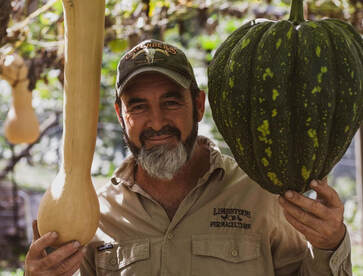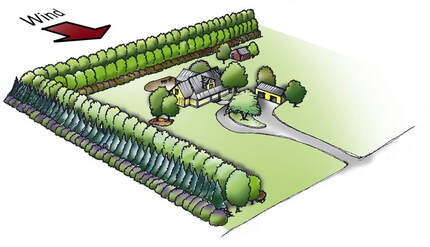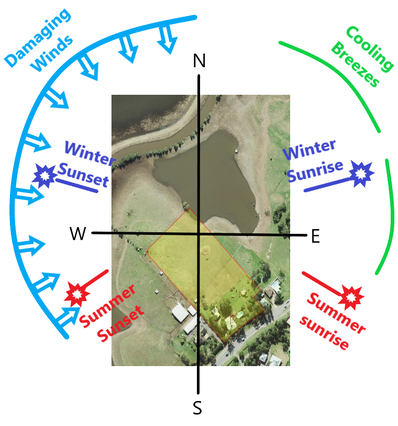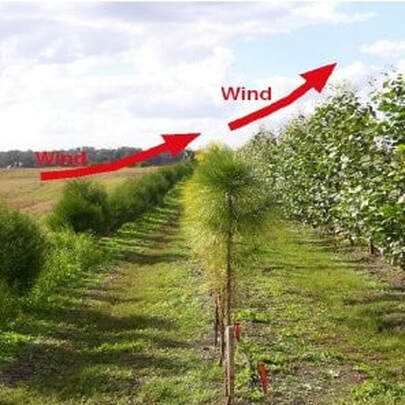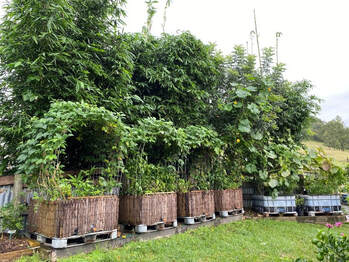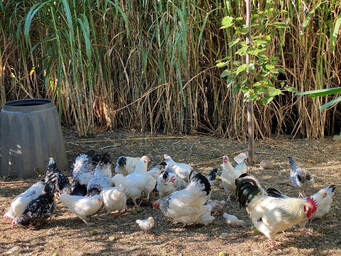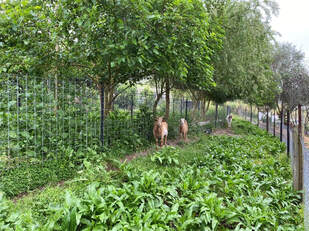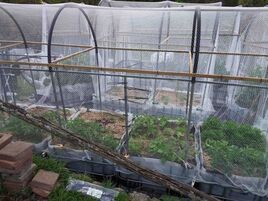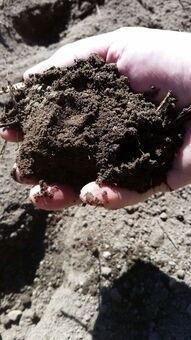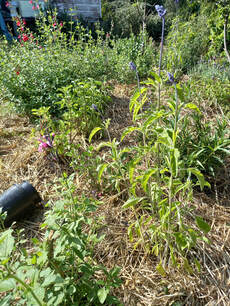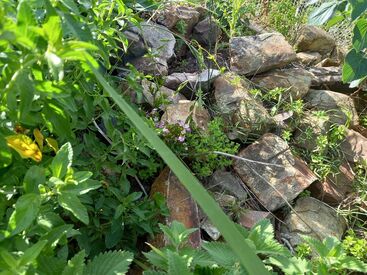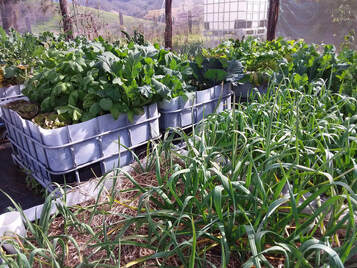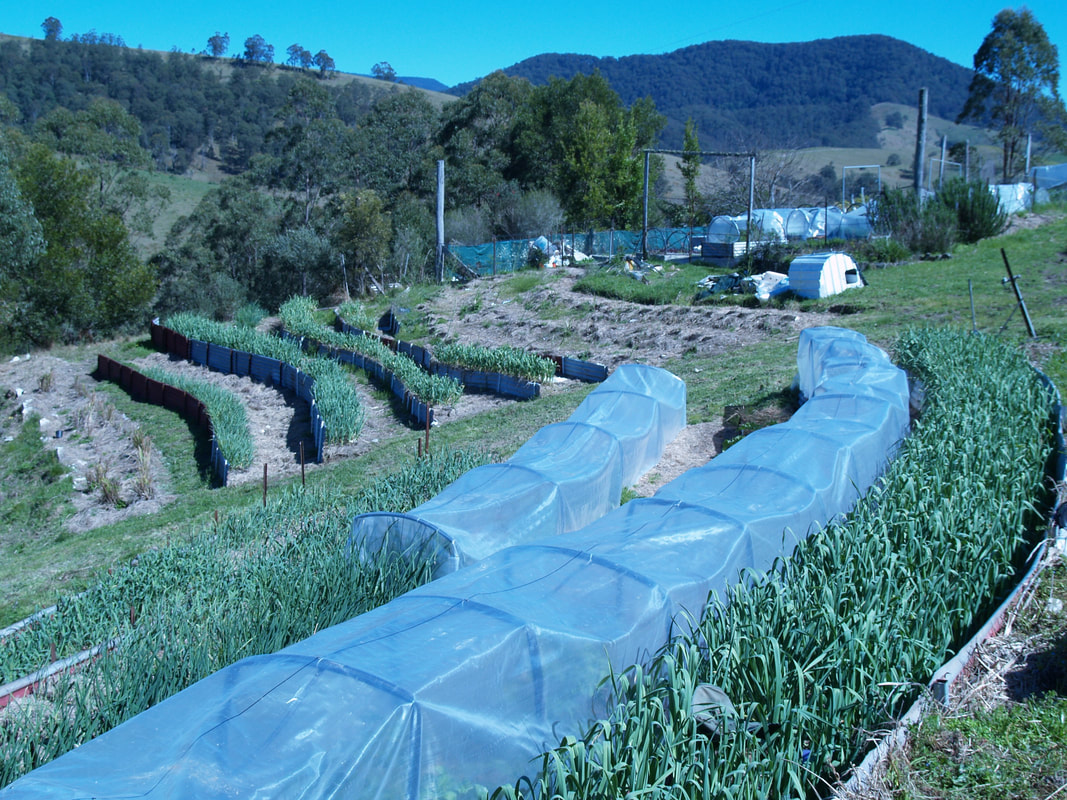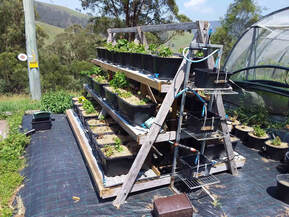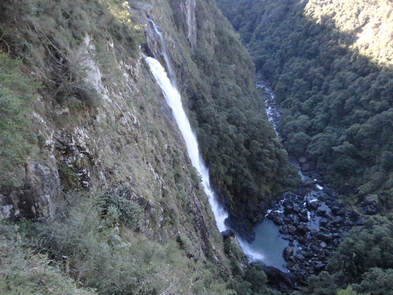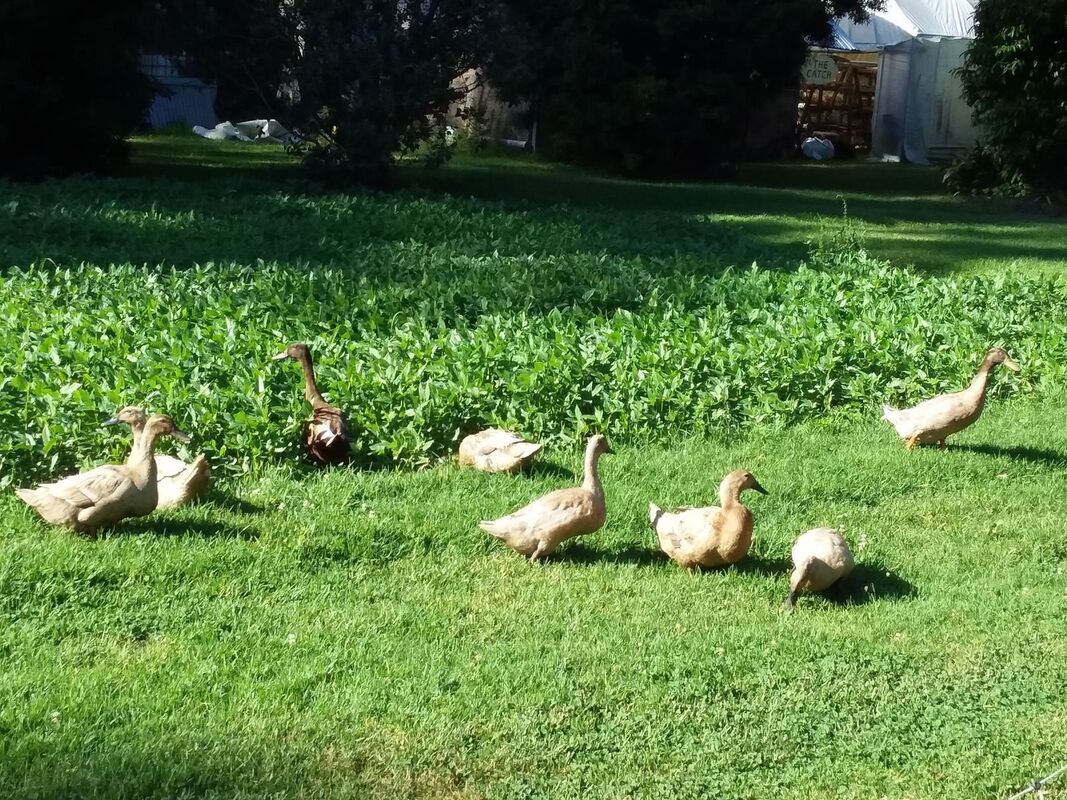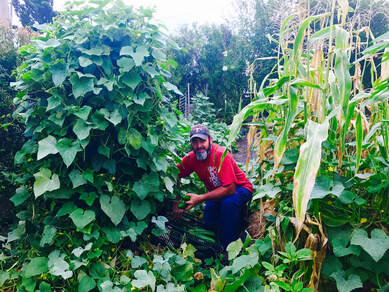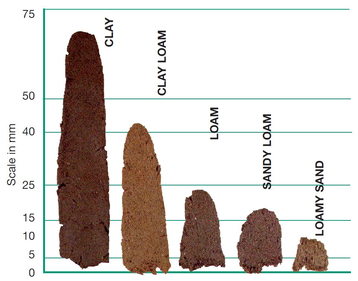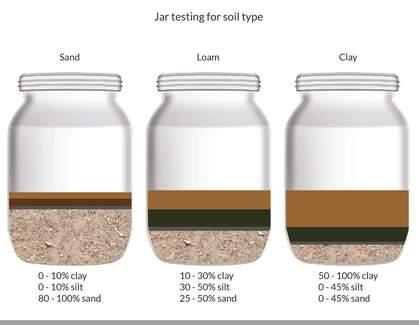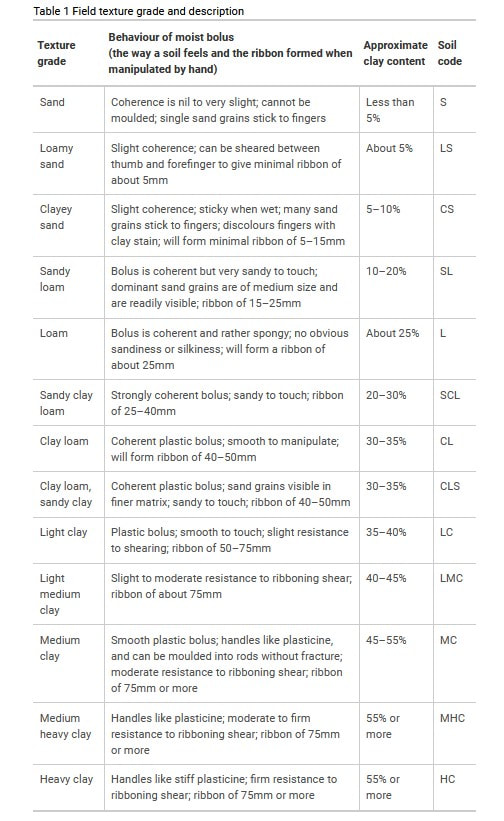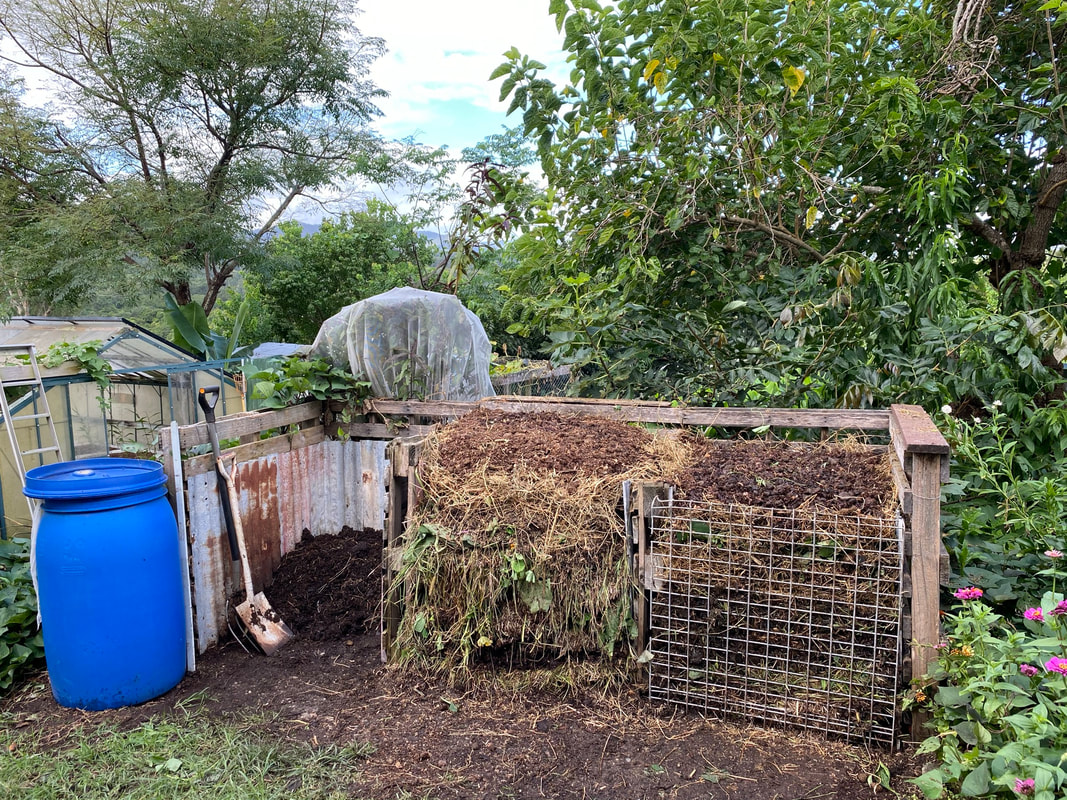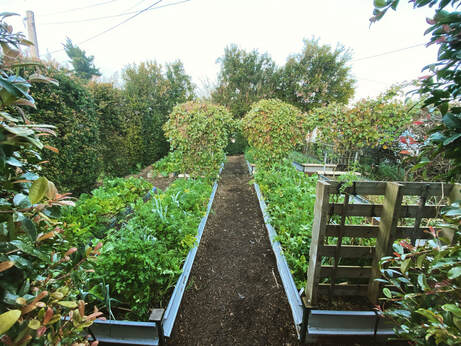Growing for the long term calls for long term solutions. Brett Cooper from Limestone Permaculture shares practical information on the inclusion of shelterbelts in your garden design as a tried and tested means of protecting your crops from wind and erosion. Brett also supplied the graphics and images.
|
Protecting your living systems
As with all successful homesteads and gardens, the initial design and planning are key! One of the most important considerations is the protection of all your living systems to provide stability and thermal comfort for you, your plants and animals. To understand where you may require these protective systems, simple observation and deduction are invaluable! |
|
Site Analysis
Note potential energies that pass through the property! Take time to observe and photograph weather events like rain, hail, frost, and winds. Focus on:
|

So let’s take a closer look at Shelterbelts
A shelterbelt is generally a tree, shrub, cane and grass system made up of one or more semi-permeable rows, planted in such a manner as to provide shelter from Wind, Sun & Storms.
What are we requiring protection from?
A shelterbelt is generally a tree, shrub, cane and grass system made up of one or more semi-permeable rows, planted in such a manner as to provide shelter from Wind, Sun & Storms.
What are we requiring protection from?
- Wind burn
- Sun burn
- Evaporation
- Soil erosion
- Wind Pruning
- Windblown dust, sand & pollution
- Retarding plant growth
- Reduced pollination
- Reduced animal comfort
- Structural damage
|
Windbreak Characteristics
|
|
Multifunctional benefits from these shelterbelts:
|
Choosing plants for Shelterbelts that have additional benefits increases its usefulness. This is called 'stacking functions'. It encourages diversity, multifunctionality and redundancy for each element requiring protection.
|
Examples of Shelterbelt trees, shrubs, canes and grasses that have stacked functions:
1. Bana Grass - perennial, fibrous, drought hardy, animal fodder {hybrid Pennisetum Americanum x P. purpureum}
2. Clumping Bamboo – many varieties, hardy, fibrous, some edible shoots, canes have many garden uses
3. Macadamia – edible nuts, evergreen, drought hardy, sheep & goat fodder
4. Casuarina (She Oak) – native, evergreen, light foliage, wide spreading, fast growing, animal fodder, frost resistant.
5. Lillypilly – native, evergreen, perennial, tolerates poor soils & drought, animal fodder, edible fruit,
6. White Aspen – native, evergreen, perennial, tolerates poor soils & drought, animal fodder, edible fruit,
7. Loquat - evergreen, perennial, tolerates poor soils & drought, animal fodder, edible fruit,
8. Acacia – many varieties, evergreen, perennial, tolerates poor soils & drought, animal fodder, nitrogen fixing
9. Olive Tree – many varieties, evergreen, perennial, tolerates poor soils & drought, animal fodder
10. Grevilleas - many varieties, evergreen, perennial, tolerates poor soils & drought, animal fodder
11. Carob tree - evergreen, perennial, tolerates poor soils & drought, animal fodder, edible beans
1. Bana Grass - perennial, fibrous, drought hardy, animal fodder {hybrid Pennisetum Americanum x P. purpureum}
2. Clumping Bamboo – many varieties, hardy, fibrous, some edible shoots, canes have many garden uses
3. Macadamia – edible nuts, evergreen, drought hardy, sheep & goat fodder
4. Casuarina (She Oak) – native, evergreen, light foliage, wide spreading, fast growing, animal fodder, frost resistant.
5. Lillypilly – native, evergreen, perennial, tolerates poor soils & drought, animal fodder, edible fruit,
6. White Aspen – native, evergreen, perennial, tolerates poor soils & drought, animal fodder, edible fruit,
7. Loquat - evergreen, perennial, tolerates poor soils & drought, animal fodder, edible fruit,
8. Acacia – many varieties, evergreen, perennial, tolerates poor soils & drought, animal fodder, nitrogen fixing
9. Olive Tree – many varieties, evergreen, perennial, tolerates poor soils & drought, animal fodder
10. Grevilleas - many varieties, evergreen, perennial, tolerates poor soils & drought, animal fodder
11. Carob tree - evergreen, perennial, tolerates poor soils & drought, animal fodder, edible beans
Through 30 years of soil improvement and management, trialing of water retention techniques, reducing evaporation, and using wicking systems, Ken and Marnie Johnston of Misty Ridge in the foothills of Barrington Tops have found water wise solutions that work. They have reduced the recommended water use for vegetable production by up to 80%, their general plant gardens rarely require watering, and they were able to continue growing through the recent extreme drought. We asked them to share their insights with us, and they were happy to do so, noting:
'There are a lot of people developing interesting techniques to maximise water use, and we don’t wish to imply that we have all the answers. Nor are we experts. We’d just like to share some of our experiences and describe some of the methods we have found helpful'.
'There are a lot of people developing interesting techniques to maximise water use, and we don’t wish to imply that we have all the answers. Nor are we experts. We’d just like to share some of our experiences and describe some of the methods we have found helpful'.
|
MidCoast Growers Network is grateful that Ken and Marnie have put pen to paper. Their full text 'Maximising water use: Insights from 30 years at Misty Ridge' can be downloaded as a printable resource. Water wise tips and techniques discussed:
- Begin with your soil - understand it, improve it - Keep your soil covered, especially through mulching - Reduce tilling and put back into the ground as much vegetation as is available - Water thoroughly and deeply rather than frequently - Plant so as to minimise evaporation - layering, dense planting, companion planting - Create shade by using cloth - Build swales - Build terraces - Construct wicking systems |
|
Begin with your soil
Gravity, transpiration and evaporation will be competing to take the water away from your soil and plants, whether you grow in in-ground beds, containers, or raised garden beds. Improving water retention begins with understanding your soils. Soils are generally made up of three sizes of soil particles - sand, silt and clay. It is their relative proportions that make up your soil texture. Generally, water retention is inversely related to permeability: sandy soils have the lowest water retention, followed by silt, and then soils high in clay. Soil structure is how the soil particles join together and the resulting pore spaces. Often the particles are clumped together into crumbs. The size of the crumbs is very important in how much air, water and nutrients a soil contains. |
Increase organic matter in your soil by adding compost. If you have heavy clay or sandy soil, it is almost impossible to add too much compost. Always aim for a balanced soil. If you have too much compost and not enough clay, then the soil can dry out quickly or become hydrophobic (water repellent).
Add worm castings and worm wee which form aggregates. These are mineral clusters that combine to withstand soil compaction and water erosion. As a result, the soil increases its water-retention ability.
You can also add biochar (charcoal that is produced by pyrolysis of biomass in the absence of oxygen), which research shows helps to retain water. Other organic soil amendments include coconut coir (a byproduct of coconut harvest), aged manure (may have high salt content), grass clippings, straw and sphagnum peat moss. Sphagnum peat itself is not recommended as it is an unsustainably harvested amendment.
Examples of inorganic amendments are vermiculite (expensive and breaks down quickly, better for container gardening) and perlite (excellent for container gardening). Perlite is considered to not hold water whereas vermiculite will do so. Add wood vinegar (also called Pyroligneous acid, Liquid Smoke or Mokusaku), a dark liquid produced when a biomass is heated in an airless container during charcoal/biochar production.
Add worm castings and worm wee which form aggregates. These are mineral clusters that combine to withstand soil compaction and water erosion. As a result, the soil increases its water-retention ability.
You can also add biochar (charcoal that is produced by pyrolysis of biomass in the absence of oxygen), which research shows helps to retain water. Other organic soil amendments include coconut coir (a byproduct of coconut harvest), aged manure (may have high salt content), grass clippings, straw and sphagnum peat moss. Sphagnum peat itself is not recommended as it is an unsustainably harvested amendment.
Examples of inorganic amendments are vermiculite (expensive and breaks down quickly, better for container gardening) and perlite (excellent for container gardening). Perlite is considered to not hold water whereas vermiculite will do so. Add wood vinegar (also called Pyroligneous acid, Liquid Smoke or Mokusaku), a dark liquid produced when a biomass is heated in an airless container during charcoal/biochar production.
Keep soil covered
Keep your soil covered. Mulch is like sunscreen for your soil, but you can also use cover crops, bark, green manures, fabric, paper, cardboard, and pebbles. Be aware that eucalyptus and pine barks feed a bacteria that causes soil platelets to form a crust.
Keep your soil covered. Mulch is like sunscreen for your soil, but you can also use cover crops, bark, green manures, fabric, paper, cardboard, and pebbles. Be aware that eucalyptus and pine barks feed a bacteria that causes soil platelets to form a crust.
|
Mulch, mulch, mulch!! Mulching shades the soil and reduces evaporation. The shading effect reduces moisture loss on hot, windy days. We use both organic and inorganic mulches.
The main problem with organic mulch is that it is often applied too thickly and mounded ‘volcano-like’ around shrub and tree trunks, causing stem rot. Since they eventually break down in the soil - adding benefits to the soil - organic mulches also need periodic topping up. |
Inorganic mulches, often used with designs such as rock gardens and Japanese gardens, can be used to create attractive and low maintenance planting beds. Gravel has benefits for fire hazard reduction. Inorganic mulches do not provide nutrients to plants and can create a few problems. For example, large areas of inorganic mulch may increase soil temperature. Black plastic does not allow water, nutrients or air to penetrate the soil. Rubber mulch may be harmful to plants. There are some general rules of thumb for applying mulch:
- Do not exceed about 12cm in depth depending on type (coarse organic mulch can be applied more thickly than fine mulch). We use thicker mulch layers in summer (up to 30cm) and have had no problems so long as we keep the mulch away from the plant stem.
- Avoid compacting fine organic mulches as this can affect oxygen transfer and water penetration when it rains
- Avoid applying organic mulch too early in the spring or in the autumn
- Place mulch near base of plants but not mounded up around it - this is particularly important for trees
- Be sure to use the correct mulch type and depth for the site and plant type. For example, the roots of some very drought tolerant plants struggle when there is too much soil moisture. Avoid using organic mulches around these plants
We use no-dig gardening methods as much as possible and have found not only is the soil quality better, but we also use less water on those areas because they have better water retention. We also have fewer muscle aches and pains with no carting to compost heaps.
Together with reduced tilling, put back into the ground as much vegetation as is available. A technique we’ve used a lot over 30 years is the pull and drop method: cut off any unwanted bits and pieces of plants, deadhead flowers, remove dead and diseased leaves, pull weeds - and where you drop them you leave them. It can look a little messy for a while but once you cover the droppings with mulch, it not only looks tidy, it increases the depth of your mulch cover and it puts nutrition back into the soil.
A thing to remember is that, as the vegetation decomposes, it is using up nitrogen. Add a little of your favourite nitrogenous fertiliser to counteract nitrogen depletion. We have few weed problems from seed heads and no significant transfer of diseases. The major diseases we found that need to be isolated and destroyed are the fusarium and verticillium wilts.
Together with reduced tilling, put back into the ground as much vegetation as is available. A technique we’ve used a lot over 30 years is the pull and drop method: cut off any unwanted bits and pieces of plants, deadhead flowers, remove dead and diseased leaves, pull weeds - and where you drop them you leave them. It can look a little messy for a while but once you cover the droppings with mulch, it not only looks tidy, it increases the depth of your mulch cover and it puts nutrition back into the soil.
A thing to remember is that, as the vegetation decomposes, it is using up nitrogen. Add a little of your favourite nitrogenous fertiliser to counteract nitrogen depletion. We have few weed problems from seed heads and no significant transfer of diseases. The major diseases we found that need to be isolated and destroyed are the fusarium and verticillium wilts.
Watering
When you water, water thoroughly and deeply rather than frequently. This gives the roots more time to absorb the water, resulting in stronger and healthier roots. A short term solution (approx six weeks) to retain water in the soil is to use a soil wetting agent. We only use organic inputs, so suggest agar agar (seaweed extract).
When you water, water thoroughly and deeply rather than frequently. This gives the roots more time to absorb the water, resulting in stronger and healthier roots. A short term solution (approx six weeks) to retain water in the soil is to use a soil wetting agent. We only use organic inputs, so suggest agar agar (seaweed extract).
|
Planting to minimise evaporation
Think of your garden as a rainforest. Create layers to help your plants work harmoniously together: canopy/tall tree - sub canopy/large shrub - shrub layer - herbaceous layer - ground cover layer - underground layer - vertical/climbing layer - wetlands- fungal layer Through this layering you can create natural balanced micro-climates which, once established, will minimise water loss and help keep water in the system. |
Plant densely and close together. This has a cooling effect on the soil and plants underneath it and helps to conserve moisture. Plants store water in sacs which are called vacuoles. They either use the water, or gradually - through transpiration - let it evaporate into the atmosphere from their leaves, stems, or flowers.
Plant in guilds or companion planting (groups of plants that grow well together) so that the taller plants protect the more delicate ones.You can find many examples of this on the internet, but one example is the three sisters: corn, beans and squash. The corn provides a natural pole for the beans to climb. The beans are a nitrogen fixing plant that pull nitrogen from the air and put it into the soil in combination with soil bacteria. Beans also give stabilising support to the corn stalk. The last sister is squash. The large leaves of the squash plant provide cover for the soil, reducing soil temperature, weeds around the plants, and retaining moisture in the soil. The prickly vines of the squash plants also provide a barrier to pests.
Plant in guilds or companion planting (groups of plants that grow well together) so that the taller plants protect the more delicate ones.You can find many examples of this on the internet, but one example is the three sisters: corn, beans and squash. The corn provides a natural pole for the beans to climb. The beans are a nitrogen fixing plant that pull nitrogen from the air and put it into the soil in combination with soil bacteria. Beans also give stabilising support to the corn stalk. The last sister is squash. The large leaves of the squash plant provide cover for the soil, reducing soil temperature, weeds around the plants, and retaining moisture in the soil. The prickly vines of the squash plants also provide a barrier to pests.
|
Create shade by using cloths
Use growing cloths during hot dry weather to reduce heat stress and water loss. White colour reflects heat while darker shades absorb heat. We utilise a range of covers and found that they all have their benefits and work when used for their specific purpose. At the lowest level of shading is exclusion cloth, which provides 10% shade. It excludes fruit fly, white cabbage butterfly, 28 spotted lady beetle, most pests, birds, insects and bugs (good and bad); but does not keep out flea beetles, aphids or spider mites. |
Shade cloths come in varying types:
- 30%-40% white is used to cover lettuce, tomatoes and other vulnerable plants in extreme heatwaves; also good for protecting your geraniums and chrysanthemums; can be left over vegetables for the entire growing season
- 50% white is used many for seed raising and propagation; also suitable for a cooling shade
- 70% is suitable for shade and cool loving plants (and people!)
- 80% is suitable for high protection
- 90% protects animals from extreme sun
- 30%-40% white is used to cover lettuce, tomatoes and other vulnerable plants in extreme heatwaves; also good for protecting your geraniums and chrysanthemums; can be left over vegetables for the entire growing season
- 50% white is used many for seed raising and propagation; also suitable for a cooling shade
- 70% is suitable for shade and cool loving plants (and people!)
- 80% is suitable for high protection
- 90% protects animals from extreme sun
Swales
Swales are grassed or vegetated broad, shallow channels that are used to collect and convey stormwater flows, promote infiltration, reduce stormwater peak flow rates and discharge volumes, and remove sediments. Here are some points which we think are important to know about swales.
Swales are grassed or vegetated broad, shallow channels that are used to collect and convey stormwater flows, promote infiltration, reduce stormwater peak flow rates and discharge volumes, and remove sediments. Here are some points which we think are important to know about swales.
- They should be built on the contour.
- They should be excavated to have level bottoms so that the water rests evenly within them, soaking throughout the terrain rather than congregating in a particular area.
- Soil is stabilized by planting vegetation on the downhill side, and the berm is also on the downhill side.
- Swales are not appropriate on steep landscapes - the land should have no more than a fifteen-degree slope (about 1:3.75).
- The swale must have a level spillway so that when there is excess water it can escape without damaging the berm.
- Swales can be used to grow trees, especially on the downhill slope.
Terraces
Terrace cultivation is a method of growing crops on sides of hills, steep land or mountains by planting on graduated terraces built into the slope. Terraces are not the same as swales. Though labour-intensive, the method has been employed effectively to maximize arable land area in variable terrains and to reduce soil erosion and water loss.
In most systems the terrace is a low, flat ridge of earth built across the slope, with a channel for runoff water just above the ridge. Usually terraces are built on a slight grade so that the water caught in the channel moves slowly toward the terrace outlet.
Terrace cultivation is a method of growing crops on sides of hills, steep land or mountains by planting on graduated terraces built into the slope. Terraces are not the same as swales. Though labour-intensive, the method has been employed effectively to maximize arable land area in variable terrains and to reduce soil erosion and water loss.
In most systems the terrace is a low, flat ridge of earth built across the slope, with a channel for runoff water just above the ridge. Usually terraces are built on a slight grade so that the water caught in the channel moves slowly toward the terrace outlet.
|
Here at Misty Ridge we use both terraces and swales but because our land is very steep we mostly utilise terracing. We have done extensive terracing for olive groves, citrus trees and general gardens.
The terraces have been formed using heavy machinery as well as hand digging in inaccessible areas. The terraces facing south retain the most moisture due to less intense sun exposure. |
Wicking Systems
Since we retired from commercial vegetable growing, we have increased our investment in wicking bed systems. Our wicking systems have evolved greatly over the last 15 years. The major advantage is a significant increase in production while conserving water. Quantities of water are stored in the reservoir, resulting in less frequent water applications, whether by rain or irrigation. This storage also increases your overall water capacity.
You can grow in all conditions, and organic growing is much easier, with hardly any weeding needed. Evaporation is significantly reduced and you have better temperature control. The systems can also incorporate water harvesting techniques that make use of smaller rains or even dew.
These are major benefits when faced with more erratic rainfall with longer periods of drought. The wicking bed system also has the ability to improve soil quality and capture significant amounts of carbon from the atmosphere. They are relatively inexpensive and easy to operate once the basic principles have been understood.
Since we retired from commercial vegetable growing, we have increased our investment in wicking bed systems. Our wicking systems have evolved greatly over the last 15 years. The major advantage is a significant increase in production while conserving water. Quantities of water are stored in the reservoir, resulting in less frequent water applications, whether by rain or irrigation. This storage also increases your overall water capacity.
You can grow in all conditions, and organic growing is much easier, with hardly any weeding needed. Evaporation is significantly reduced and you have better temperature control. The systems can also incorporate water harvesting techniques that make use of smaller rains or even dew.
These are major benefits when faced with more erratic rainfall with longer periods of drought. The wicking bed system also has the ability to improve soil quality and capture significant amounts of carbon from the atmosphere. They are relatively inexpensive and easy to operate once the basic principles have been understood.
What is soil?
Soil is a combination of three components or properties (NSW Local Land Services 2020):
- Physical properties - these include the soil's structure, its texture (the ratio of sand, silt and clay), and its colour
- Chemical properties - the soil's ability to hold nutrients (also known as its Cation Exchange Capacity - CEC), soil pH, and the nutrients present, for example nitrogen (N), phosphorous (P), and potassium (K)
- Biological properties - the organic matter, microbes and macrofauna (such as worms) present in the soil.
|
Network member Joёl Dunn, Local Landcare Coordinator, Karuah & Great Lakes Landcare, makes the point that it's inherently tricky to make general comments about "local" growing conditions across the MidCoast LGA. Key messages about soil health regardless of underlying geology etc are
|
We have everything from bordering on subtropical to subalpine (snow-prone tops country), and a variety of soil types. Soils tend to be acidic, and tend to have limiting levels of available soil Phosphorus. |
|
Steps to Soil
|
“It’s not the soil itself – it’s the soil life that is the most important element.” (Geoff Lawson)
|
|
Stacey Mitchell has put together a compendium of tips for growers on building your soil. In 'Steps to Soil', which you can also download as a printable resource, Stacey focuses on:
As she writes: Begin thinking about the basics: conduct some home experiments (refer more specifically to Brett Cooper’s 'Tips and techniques for soil health', below) including soil pH, soil texture tests, soil water retention tests to understand what you’re working with. This gives you an idea of what your particular site is lacking in, and what companions it will need to create your desired drainage, pH and texture. |
In putting together this resource, Stacy draws on: Wiltshire, R., 2021. KPZ001 the Science of Gardening. [online]. Available at: <https://mylo.utas.edu.au/d2l/le/content/469926/viewContent/4061199/View> [Accessed 17 November 2021]. |
The consistent theme across the board seems to be the necessity to introduce organic matter. The symbiotic relationships among plants, fungi, insects and animals is complex but first of all you must begin the food chain!
Regardless of the soil type, organic matter is going to begin the process of feeding beneficial microbes and macro-organisms that will begin rectifying your soil in preparation for more life. This refers not only to the inoculation of compost and manure to a particular site, but also the necessity to introduce or attract life in the form of specific plants, micro-organisms, macro-organisms, insects, birds and animals.
Regardless of the soil type, organic matter is going to begin the process of feeding beneficial microbes and macro-organisms that will begin rectifying your soil in preparation for more life. This refers not only to the inoculation of compost and manure to a particular site, but also the necessity to introduce or attract life in the form of specific plants, micro-organisms, macro-organisms, insects, birds and animals.
What nutrients does your soil hold and what nutrients will you need?
A good indication of nutrient availability in soils is reading plants, knowing them well enough to know what a healthy version of them looks like and what symptoms are typical of a nutrient deficiency. If established plants are present on your working site take note of what species are there and whether they are healthy or not, both will indicate nutrients. Alternatively you could send away a soil test or install some test subject plants to know.
A good indication of nutrient availability in soils is reading plants, knowing them well enough to know what a healthy version of them looks like and what symptoms are typical of a nutrient deficiency. If established plants are present on your working site take note of what species are there and whether they are healthy or not, both will indicate nutrients. Alternatively you could send away a soil test or install some test subject plants to know.
|
Bill Mollison has said: “You don’t have a problem with snails you have a duck deficiency”.
The same concept can be applied across the board in permaculture especially when it comes to soil. Counterbalancing the sand with nutrient-rich organic matter, the clay with sand and counterbalancing the sand all contributes to producing your desirable loam recipe of roughly 40% sand, 40% silt, and 20% clay. |
Depending on your soil type and history of the site the pH of the soil will vary.
A pH from 5.5 - 7.5 is ideal for gardens, each individual plant will rely on a specific pH for maximum performance but this is the branch by which plants thrive. Altering the pH can be achieved by adding different materials.
To increase pH making soil more neutral, add limestone, ash or dried pine needles.
To lower the pH, add organic matter or sulphur for more acidic soils.
A pH from 5.5 - 7.5 is ideal for gardens, each individual plant will rely on a specific pH for maximum performance but this is the branch by which plants thrive. Altering the pH can be achieved by adding different materials.
To increase pH making soil more neutral, add limestone, ash or dried pine needles.
To lower the pH, add organic matter or sulphur for more acidic soils.
Micro-organisms include bacteria, fungi, protozoa and algae. Their role is to decompose organic matter and transform into nutrient, fix nitrogen from air into soil and feed the rest of the food chain.
Macro-organisms include; earthworms, nematodes, ants and centipedes who consume organic matter and mix it.
Macro-organisms include; earthworms, nematodes, ants and centipedes who consume organic matter and mix it.
Tips and techniques for soil health - Brett Cooper
|
We asked Brett Cooper from Limestone Permaculture at Stroud Road specific questions about working with the soil, and here he shares his insights with us. |
What is the easiest way to find out about the current condition of the soil on my property? |
The easiest way to determine your current soil condition is by using the Landcare RASH guide (Rapid Assessment of Soil Health) and Score Card.
Manually assessing your garden soil requires a few simple tests and the use of a few of your senses. Let's look at estimating or measuring: soil texture; soil moisture; drainage; soil pH; compaction (including testing for water infiltration); and the percentage of organic matter. |
Texture of soil
Soil texture is an estimate of the amount of sand, silt and clay particles present in the soil. Estimating or measuring soil texture provides valuable information about soil properties affecting plant growth. Soil texture affects the movement and availability of air, nutrients and water in a soil. A simple and quick measure of soil texture is the way a soil looks in a 'JAR TEST' and feels when manipulated by 'RIBBON TEST'.
Soil texture is an estimate of the amount of sand, silt and clay particles present in the soil. Estimating or measuring soil texture provides valuable information about soil properties affecting plant growth. Soil texture affects the movement and availability of air, nutrients and water in a soil. A simple and quick measure of soil texture is the way a soil looks in a 'JAR TEST' and feels when manipulated by 'RIBBON TEST'.
|
For the Ribbon test
1. Grab a small handful of soil (if dry add a small amount of water to make moist) so as to make a ball (bolus). 2. Knead the ball (bolus) for about 30 seconds. Note how the soil feels when kneading it: gritty (sandy), silky (silty) or plastic/sticky (clay). If you can’t make a ball, the soil is very sandy. 3. Gently press out the soil between your thumb and index finger to form a hanging ribbon. The ribbon should only be 2–3mm thick. The more clay you have in your soil, the longer your ribbon will be. |
|
For the Jar Test Simply add 1/3 garden soil (sticks / rocks removed) to a jar, fill with water, apply lid and shake. Leave for 24 hours, and visually check the percentage of clay, silt, and sand layers. There maybe an organic layer as well. A more detailed analysis and description using the Ribbon test is provided in the table below. |
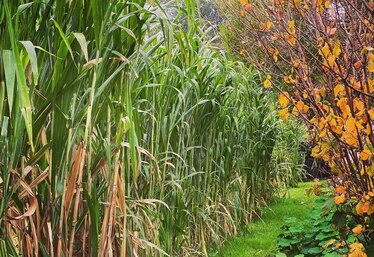 Bana grass windbreak (Photo: Brett Cooper)
Bana grass windbreak (Photo: Brett Cooper)
Soil Moisture
The feel of the soil is the best guide. As a general rule for most annual vegetables, if you probe with your hand down approximately half the depth of the root zone (of the plants you're growing around where you are testing) and its dry to the touch, then it requires watering. Ideally to prevent soil moisture loss (evaporation), ensure garden protection from winds and afternoon summer sun, adequate mulching and / or living ground cover.
The feel of the soil is the best guide. As a general rule for most annual vegetables, if you probe with your hand down approximately half the depth of the root zone (of the plants you're growing around where you are testing) and its dry to the touch, then it requires watering. Ideally to prevent soil moisture loss (evaporation), ensure garden protection from winds and afternoon summer sun, adequate mulching and / or living ground cover.
Drainage
Do a Percolation Test (Drainage test):
Do a Percolation Test (Drainage test):
- Dig a hole approximately 40cm deep and at least 15cm in diameter.
- Fill the hole with water and leave to drain for an hour.
- Fill the hole with water again and watch how fast the water drains.
- If the water sits in the hole it's poorly-drained.
- If after an hour the level has a couple of centimetres it's moderately well-drained.
- If it drains faster than that, it's considered very well-drained.
pH of soil
The pH of the soil indicates its level of acidity and alkalinity. Our preferred test kit is the CSIRO pH Test Kit. To do a pH test:
The pH of the soil indicates its level of acidity and alkalinity. Our preferred test kit is the CSIRO pH Test Kit. To do a pH test:
- Take soil from a number of locations around the garden.
- Remove larger particles and place about 1 teaspoon of the soil onto the white testing kit plate.
- Create a well in the centre of the pile, add a few drops of the indicator dye and mix it through.
- Sprinkle the powder supplied onto the pile and wait for about 30 seconds. Compare the colour with that in the test kit to determine what your pH is.
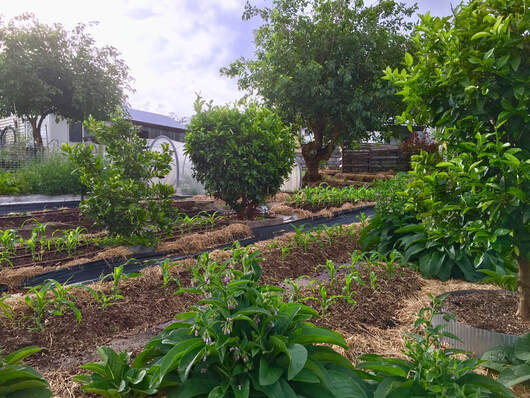 The new corn is thriving in the well-prepared soil (Photo: Brett Cooper)
The new corn is thriving in the well-prepared soil (Photo: Brett Cooper)
|
Compaction
Why is compaction important?
Water infiltration is directly related to compaction and is the process by which water reaches plant roots. Good water infiltration not only gets water to your plants’ root, it helps prevent erosion and runoff. It also improves aeration. |
Testing for Water Infiltration
- Use a length of 90mm dia PVC pipe approximately 200mm long. - Push it into the soil, to approximate root depth of surrounding plants, leaving at least 75mm above soil level. - Fill the visible portion with water. - Mark the water height. - Time how long it takes the soil to absorb the water. - Repeat until the absorption rate slows and the time to absorption is consistent. If slower than 25mm per hour, your soil is likely to be compacted. |
|
Organic Assessment
- Remove a spade of soil from the garden - Spread over a tarp or flat surface - Inspect for the volume of critters / bugs within the spadeful: you are looking for evidence of life! - Look for earthworm casts and burrows, and count worms if possible (you would expect to have at least 10 worms to the spade full). The benefits of earthworms go beyond aeration. These friendly critters leave behind secretions that improve tilth, as well as adding organic matter, bacteria, plant nutrients and enzymes via their casts. - Note the approximate percentage of organic matter over soil. |
How should I deal with compacted garden soil? |
Working organic matter like compost into the soil (photo), applying bioferts like seaweed and fish emulsion, and applying mulch are the most effective ways to treat compacted soils.
The soil organisms that break down organic matter also aerate the soil in the process. |
|
If considering market gardening, it may be worth undertaking an initial lab test to determine exactly what is and isn't available in your soils.
For general backyard gardens, simple soils tests as described are enough to help make positive change. |
When do you think it is worth paying for a comprehensive soil test? |
I know moisture is needed to make soil nutrients available to plants. Given the extended dry periods we experience, in particular during the winter and spring months, what is the best way to keep moisture in the soil and nutrients available to plants? |
A successful garden means creating a stable environment (micro-climate) that allows soil to retain moisture, provides regular nutrients, and accommodates soil life thus promoting success in the garden! This can be achieved by:
- Garden windbreaks that can be grown or created from materials to protect from summer and winter winds - Garden Summer Sun Shading that can be grown or created from materials to protect from midday to evening summer sun. - Ground Cover using organic mulching and / or living ground cover plants. - Living soils with high organic matter provided by compost, bio-fertilisers, bio-stimulants, mulch etc. - Irrigation planning and management. |
|
Join Stef Garland as she goes on a guided tour of Brett's garden
|
|
MidCoast Council, a sponsor of our Network, encourages residents to get involved in composting and gardening, and notes, within the context of their Scraps to Soil program:
'If you're lacking space, resources or motivation to create a garden at home, you can still keep your green thumbs by getting involved with one of the many local community gardens across the MidCoast region'. |
Compost hubs can be found at the community gardens listed below. You can contact them to register as a Compost Crusader, as well as for details on other ways to get involved.
Cundletown: Main Street (opposite the Post Office). Drop in and meet the team, phone Theo on 7903 2495 or email [email protected]
Forster: Little Street (next to Forster Neighbourhood Centre). Drop in on a Tuesday morning, call 6555 4351 or email [email protected]
Gloucester: The new Gloucester Community Garden has opened in District Park. See our featured event - 'Gloucester Community Garden established'.
Nabiac: 37 Nabiac Street (rear of Neighbourhood Centre). Email Joel at [email protected] or call him on 0401 932 533
Taree: PCYC, 95 Commerce Street. For more information email Michelle at [email protected]
Tuncurry: The Green at the Waste Management Centre, Midge Orchid Road (opposite the re-use shop). Drop in on a Wednesday morning, call Krysten on 6554 9471 or email [email protected]
Wingham: 4 Farquhar Street (rear of Manning Valley Neighbourhood Centre). For more information email [email protected]
Cundletown: Main Street (opposite the Post Office). Drop in and meet the team, phone Theo on 7903 2495 or email [email protected]
Forster: Little Street (next to Forster Neighbourhood Centre). Drop in on a Tuesday morning, call 6555 4351 or email [email protected]
Gloucester: The new Gloucester Community Garden has opened in District Park. See our featured event - 'Gloucester Community Garden established'.
Nabiac: 37 Nabiac Street (rear of Neighbourhood Centre). Email Joel at [email protected] or call him on 0401 932 533
Taree: PCYC, 95 Commerce Street. For more information email Michelle at [email protected]
Tuncurry: The Green at the Waste Management Centre, Midge Orchid Road (opposite the re-use shop). Drop in on a Wednesday morning, call Krysten on 6554 9471 or email [email protected]
Wingham: 4 Farquhar Street (rear of Manning Valley Neighbourhood Centre). For more information email [email protected]
Read more about the Scraps to Soil program, and get practical information on composting, mulching and worm farming in 'From the soil up', Part 1 of our MidCoast Growers’ Guide: Building Resilience to a Changing Climate
Digging DeeperFor readers who want to dig a little deeper, Ron Woods is your guide to articles and other readings on a range of topics of interest to growers at all stages of their journeys.
|

